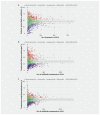Influences on the start, selection and duration of treatment with antibiotics in long-term care facilities
- PMID: 28652480
- PMCID: PMC5489391
- DOI: 10.1503/cmaj.161437
Influences on the start, selection and duration of treatment with antibiotics in long-term care facilities
Abstract
Background: Understanding the extent to which current antibiotic prescribing behaviour is influenced by clinicians' historical patterns of practice will help target interventions to optimize antibiotic use in long-term care. Our objective was to evaluate whether clinicians' historical prescribing behaviours influence the start, prolongation and class selection for treatment with antibiotics in residents of long-term care facilities.
Methods: We conducted a retrospective cohort study of all physicians who prescribed to residents in long-term care facilities in Ontario between Jan. 1 and Dec. 31, 2014. We examined variability in antibiotic prescribing among physicians for 3 measures: start of treatment with antibiotics, use of prolonged durations exceeding 7 days and selection of fluoroquinolones. Funnel plots with control limits were used to determine the extent of variation and characterize physicians as extreme low, low, average, high and extreme high prescribers for each tendency. Multivariable logistic regression was used to assess whether a clinician's prescribing tendency in the previous year predicted current prescribing patterns, after accounting for residents' demographics, comorbidity, functional status and indwelling devices.
Results: Among 1695 long-term care physicians, who prescribed for 93 132 residents, there was wide variability in the start of antibiotic treatment (median 45% of patients, interquartile range [IQR] 32%-55%), use of prolonged treatment durations (median 30% of antibiotic prescriptions, IQR 19%-46%) and selection of fluoroquinolones (median 27% of antibiotic prescriptions, IQR 18%-37%). Prescribing tendencies for antibiotics by physicians in 2014 correlated strongly with tendencies in the previous year. After controlling for individual resident characteristics, prior prescribing tendency was a significant predictor of current practice.
Interpretation: Physicians prescribing antibiotics exhibited individual, measurable and historical tendencies toward start of antibiotic treatment, use of prolonged treatment duration and class selection. Prescriber audit and feedback may be a promising tool to optimize antibiotic use in long-term care facilities.
© 2017 Canadian Medical Association or its licensors.
Conflict of interest statement
Competing interests: None declared.
Figures


References
-
- Pakyz AL, Dwyer LL. Prevalence of antimicrobial use among United States nursing home residents: results from a national survey. Infect Control Hosp Epidemiol 2010;31:661–2. - PubMed
-
- Nicolle LE, Bentley DW, Garibaldi R, et al. Antimicrobial use in long-term-care facilities. SHEA Long-Term-Care Committee. Infect Control Hosp Epidemiol 2000;21:537–45. - PubMed
-
- Rotjanapan P, Dosa D, Thomas KS. Potentially inappropriate treatment of urinary tract infections in two Rhode Island nursing homes. Arch Intern Med 2011;171:438–43. - PubMed
Publication types
MeSH terms
Substances
LinkOut - more resources
Full Text Sources
Other Literature Sources
Medical
Research Materials
